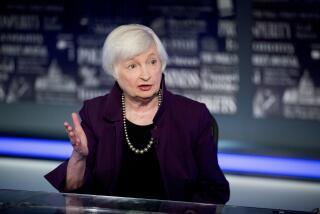U.S. credit downgrade unlikely to fix logjam in Congress
- Share via
Reporting from Washington — The historic decision by Standard & Poor’s to downgrade the U.S. credit rating may provoke some havoc in financial markets this week, but it’s unlikely to deliver the shock necessary to prod Washington politicians to take the unpopular steps required to cut the nation’s debt.
A key to the political effects of the downgrade will be the reaction of financial markets Monday.
Yet the markets might barely shudder, analysts said, partly because S&P damaged its credibility with its miscalculation of subprime mortgage risk during the housing boom. Besides, two other major companies maintained their top ratings of U.S. debt, at least for now, and investors worldwide still flocked to U.S. Treasury bonds as safe havens.
“The markets instill discipline on politicians and governments. It’s got to be a scarier reaction than we’re likely to see,” said Chris Rupkey, chief financial economist at the Bank of Tokyo-Mitsubishi in New York. “There’s too much disagreement at this stage.”
Still, the humbling message it sent about the finances of the world’s superpower is a marker for the depths of the U.S. budget problems and the inability of Washington to rise above politics to solve it.
Wall Street executives, Washington policymakers and world leaders moved quickly to gauge the fallout. On Saturday, they began grappling with S&P’s decision to lower the rating a notch on long-term U.S. debt to AA+ from the top-level AAA.
The Chinese government, the largest foreign holder of U.S. debt, reacted strongly, saying the country needed to “learn to live within its means.” Leaders worldwide set up conference calls Saturday and Sunday to discuss the ramifications of the downgrade in light of the ongoing European debt crisis that helped spark Thursday’s stock market meltdown.
Treasury officials were talking to a wide range of investors to try to mitigate any short-term negative effects.
Wall Street firms expect investors to make a run for safety when the Asian markets open Sunday night and U.S. markets open the next morning, but few are predicting anything close to a catastrophe.
“It’s more kind of psychological than anything else,” said a person at one Wall Street firm, who requested anonymity because of the sensitivity of the financial situation.
The White House was quick to seize on S&P’s criticism of U.S. political leaders for failing to take tougher steps to rein in soaring budget deficits. On Saturday, President Obama’s aides called on Democrats and Republicans to place the nation’s economic future “above our political and ideological differences.”
Even as they hoped the downgrade would spur more bipartisan compromise, officials sought to downplay the financial effect. They said the analysis that led to the decision was flawed and noted that the other two leading credit rating companies, Moody’s Investors Service and Fitch Ratings, decided last week to maintain their triple-A ratings for U.S. debt, at least for now.
“It smacked of an institution starting with a conclusion and shaping any arguments to fit it,” said top White House economic advisor Gene Sperling.
But the politics of the downgrade work both ways.
No president wanted the U.S. to lose its AAA rating on his watch. Yet S&P’s suggestion that spending cuts and revenue increases were needed to solve the problem could put pressure on Republicans to soften their resistance to tax hikes.
In the coming months, a special 12-member congressional committee will be looking for ways to cut the deficit by hundreds of billions of dollars. Obama will crisscross the country, making the case that tax increases should be part of the mix. S&P’s downgrade gives fuel to his argument, administration officials said.
At least initially, however, Republicans appeared to be digging in on their opposition to more taxes.
Rep. Marsha Blackburn (R-Tenn.) equated the downgrade with getting “hit in the head with an anvil.” She called for the White House to agree to deeper spending cuts.
“The Obama administration must get on board with Republican efforts to cut up the credit cards and put our economy back on the path to prosperity,” she said.
Such reaction highlighted the political stalemate that S&P said was more of a factor in its downgrade than the nation’s unsustainable fiscal trajectory.
“In our observation, it has been extraordinarily difficult to get all sides together on a consensus about what sort of spending and taxation choices need to be made to stabilize the U.S. government’s debt burden,” said David Beers, S&P’s head of sovereign ratings.
Without a severe market reaction, the political stalemate is likely to continue, said Norman Ornstein, a congressional expert at the American Enterprise Institute for Public Policy Research.
“It is going to increase interest rates, and that, in turn, is going to make the battle to deal with the debt problem steeper,” he said. “But it seems to me it’s going to take a bigger jolt than that for Republicans to move away from the ‘my way or the highway’ approach we’ve seen.”
Anticipating a potential downgrade, some liberals have raised questions about the reliability of S&P’s pronouncements, given the failures it and other ratings firms displayed during the housing market boom that helped trigger the 2008 financial crisis.
Administration officials questioned S&P’s calculations, saying the downgrade was based on a flawed analysis that anticipated the budget deficit over the next decade would be $2 trillion higher than it will be.
“I find it interesting to see S&P so vigilant now in downgrading the U.S. credit rating,” said Sen. Bernie Sanders (I-Vt.). “Where were they four years ago when they and other credit rating agencies helped cause this horrendous recession by providing AAA ratings to worthless subprime mortgage securities on behalf of Wall Street investment firms?”
Berkshire Hathaway Chief Executive Warren Buffett was publicly critical of the downgrade, saying it made no sense.
“In Omaha, the U.S. is still AAA,” he told Fox Business. “In fact, if there were a quadruple-A rating, I’d give the U.S. that.”
Because of such sentiments, financial markets might not react negatively, and U.S. taxpayers could be spared the sharply higher interest rates that normally accompany a credit downgrade — something consumers taking out mortgages or car loans would welcome.
To be sure, the U.S. fiscal situation has long been public knowledge. And the shortcomings of the deal to raise the nation’s debt ceiling did not prevent investors from flocking to the perceived safe haven of Treasury securities during last week’s market chaos, driving down borrowing costs.
“The rating agencies were not elected by the American people to make public policy,” Rupkey said. “The U.S. is not out of money. It has the financial resources to make good on its debts and should not have been downgraded.”
S&P officials defended their decision Saturday. They said they constructed an alternate scenario that reduced the long-term budget deficit by $2 trillion and still determined the rising U.S. debt did not justify a AAA rating.
The debt-ceiling deal cuts spending over the next decade by $2.1 trillion to $2.4 trillion — well short of the $4 trillion that S&P warned last month would be needed. And the deal does not address the main driver of the escalating budget deficits: entitlement programs such as Medicare whose costs are soaring.
“You’re going to need eventually either some action on entitlements … or raising additional revenue to pay for these programs,” said John Chambers, S&P’s managing director of sovereign ratings.
Times staff writers David Pierson in Beijing, Peter Nicholas in Washington and Nathaniel Popper in New York contributed to this report.
More to Read
Inside the business of entertainment
The Wide Shot brings you news, analysis and insights on everything from streaming wars to production — and what it all means for the future.
You may occasionally receive promotional content from the Los Angeles Times.











